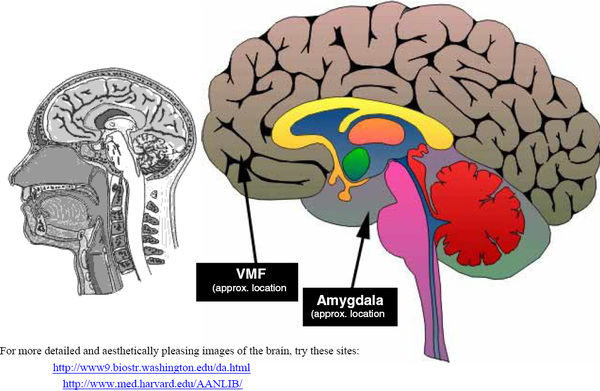Much of the neuroscientific literature on gambling focuses on the anatomy and chemistry of gambling as a pathology [see WAGER issues 2(18), 3(24), 3(30), 3(33), 4(1), 4(22), etc.). But abnormal psychology is not the only field to be placed under the lens of biomedicine. Much effort has also been dedicated to understanding the neurobiology of how we gamble. By learning about how non-compulsive subjects gamble, we may in the future be able to better understand how pathological subjects gamble. In a recent study, Bechara, Damasio, Damasio, and Lee (1999)1 use a relatively simple methodology to determine how various brain structures contribute to the decision-making process used to evaluate gambling situations.
In previous work, Damasio (1995) 2 proposed the somatic marker hypothesis, which states that certain parts of the prefrontal cortex (see figure below) associate particular decision-making situations with particular emotions. These emotions express themselves primarily through changes in body states, which may be conscious or unconscious. When an individual is presented with a familiar task, the prefrontal cortex reactivates the somatic state associated with the situation. The reoccurrence of the somatic state acts as a reference point, or marker, by which the brain can quickly retrieve stored information relevant to the task. This information helps the individual make an informed decision in a short amount of time. Without the presence of a somatic marker, the individual approaches the task without the benefit of prior learning. Several structures of the prefrontal cortex have been implicated in this process. Bechara et al. consider two particular structures, the amygdala and the ventromedial prefrontal cortex (VMF), and chose skin conductance responses (SCR) to measure shifts in somatic state.
The authors assembled three groups: a cohort of patients with damaged amygdalas (n=5), a cohort with damaged VMFs (n=5), and a normal control group (n=13). Each subject was presented with four decks of cards. Each card chosen resulted in a net loss or n gain of money. Decks A and B were stacked with cards that were generally disadvantageous to the subject, while C and D were stacked to be advantageous. Subjects were told to choose 100 cards, one at a time. All subjects approached the task with no knowledge about the cards or how they were grouped. After a period of trial and error, normal subjects figured out the compositi of the decks and subsequently chose cards from C and D. Both groups of brain-damaged subjects did not exhibit this eventual preference for the advantageous decks, and generally continued to choose more cards from A and B.
In addition, the authors discovered differential roles for the two structures. They found that, in general, the amygdala patient unable to evoke somatic states (as measured with SCRs) after winning and losing money on individual card draws. VMF patients, however, did demonstrate body state changes after winning and losing. This suggests that patients with damaged VMFs are unable to successfully integrate the somatic state information as mediated through the amygdala. In summary, it seems that damage to th amygdala results in an inability to create the somatic changes that normally become associated with decision-making situations such as the gambling task. In contrast, damage to the VMF results in a failure to properly recognize and interpret these somatic changes when they reoccur.
By differentiating the roles played by the amygdala and the VMF, the authors have shed light on the neurobiology of gambling in non-pathological subjects. As the "decade of the brain" draws to a close, it is possible that the knowledge gained from studies as this one will one day help us to better understand the functional anatomy of not only compulsive gambling, but of all disorde that involve the decision-making process.
Source: 1 Bechara, A., Damasio, H., Damasio, A.R., & Lee, G.P. (1999) Different contributions of the human amygdala and ventromedial prefrontal cortex to decision-making. The Journal of Neuroscience, 19, 13, 5473-5481. 2 Damasio, A.R. (1995). Structure and functions of the human prefrontal cortex. In J. Grafman, K.J. Holyoak, et al. (Eds.). Annals of the New York Academy of Sciences, Vol. 769. (pp. 241-251). New York: New York Academy of Sciences.
The WAGER is funded, in part, by the National Center for Responsible Gaming, the Massachusetts Department of Public Health, the Andrews Foundation, the Addiction Technology Transfer Center of New England, the Substance Abuse and Mental Health Administration Services, and the Center for Substance Abuse Treatment.




